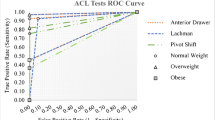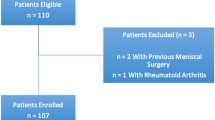Abstract
Background: Chondral lesions of the knee are commonly found during arthroscopic partial meniscectomy. The literature advises against arthroscopic medial meniscectomy in the presence of advanced chondral derangement because of unfavorable outcome. Recent studies have shown an association between obesity and chondropathy in patients with meniscal tears. The aim of this study was to assess whether body mass index (BMI) correlates with the severity of chondral lesions in patients with isolated medial meniscus tears (i.e. without ligamentous or lateral meniscal injury).
Materials and Methods: 837 knee arthroscopies were performed in a regional referral center of arthroscopic surgery between January 2011 and December2012. Ofthese 168 (109 males, 59 females) patients with no axial knee deformity and no radiological signs of osteoarthritis who have had arthroscopic debridement for isolated torn medial meniscus were included in the study. The correlation between different demographic factors and the level of chondral damage reported at surgery was evaluated. The mean age of patient was 50 years (range 13–82 years) and an average BMI was 28.2 kg/m2 (rangel 7.5–42.5 kg/m2).
Results: Overall, regression analysis showed both age and BMI to be linearly correlated to chondral score (r = 0.53, P < 0.04); however, there were no advanced chondral lesions found in patients younger than 40 years of age and all severe lesions were at age 50 years or more. Therefore, further analysis was performed for age subgroups: patients were grouped as younger than 40, between the age of 40 and 50 (middle age) and older than 50 years. The BMI was linearly correlated to the severity of chondral score exclusively in the middle aged group (i.e. 40–50 years old). There was no correlation between activity level and chondral damage. Women had worse chondral lesions than men in all age groups.
Conclusion: Higher BMI in middle aged patients with isolated medial meniscus tears and unremarkable radiographs may predict more advanced chondral lesions at arthroscopy.
Similar content being viewed by others
References
Del Pizzo W, Fox JM. Results of arthroscopic meniscectomy. Clin Sports Med 1990;9:633–9.
Garrett WE Jr, Swiontkowski MF, Weinstein JN, Callaghan J, Rosier RN, Berry DJ, et al. American Board of Orthopaedic Surgery Practice of the Orthopaedic Surgeon: Part-II, certification examination case mix. J Bone Joint Surg Am 2006;88:660–7.
Matsusue Y, Thomson NL. Arthroscopic partial medial meniscectomy in patients over 40 years old: A 5-to 11-year followup study. Arthroscopy 1996;12:39–44.
Greis PE, Bardana DD, Holmstrom MC, Burks RT. Meniscal injury: I. Basic science and evaluation. J Am Acad Orthop Surg 2002;10:168–76.
Jorgensen U, Sonne-Holm S, Lauridsen F, Rosenklint A. Long term followup of meniscectomy in athletes. A prospective longitudinal study. J Bone Joint Surg Br 1987;69:80–3.
Bonamo JJ, Kessler KJ, Noah J. Arthroscopic meniscectomy in patients over the age of 40. Am J Sports Med 1992;20:422–8.
Johnson RJ, Kettelkamp DB, Clark W, Leaverton P. Factors effecting late results after meniscectomy. J Bone Joint Surg Am 1974;56:719–29.
Covall DJ, Wasilewski SA. Roentgenographic changes after arthroscopic meniscectomy: Five-year followup in patients more than 45 years old. Arthroscopy 1992;8:242–6.
Calle EE, Rodriguez C, Walker-Thurmond K, Thun MJ. Overweight, obesity, and mortality from cancer in a prospectively studied cohort of U.S. adults. N Engl J Med 2003;348:1625–38.
Blagojevic M, Jinks C, Jeffery A, Jordan KP. Risk factors for onset of osteoarthritis of the knee in older adults: A systematic review and meta-analysis. Osteoarthritis Cartilage 2010;18:24–33.
Fabricant PD, Rosenberger PH, Jokl P, Ickovics JR. Predictors of short-term recovery differ from those of long term outcome after arthroscopic partial meniscectomy. Arthroscopy 2008;24:769–78.
Kirkley A, Birmingham TB, Litchfield RB, Giffin JR, Willits KR, Wong CJ, et al. A randomized trial of arthroscopic surgery for osteoarthritis of the knee. N Engl J Med 2008;359:1097–107.
Marx RG. Arthroscopic surgery for osteoarthritis of the knee? N Engl J Med 2008;359:1169–70.
Ciccotti MC, Kraeutler MJ, Austin LS, Rangavajjula A, Zmistowski B, Cohen SB, et al. The prevalence of articular cartilage changes in the knee joint in patients undergoing arthroscopy for meniscal pathology. Arthroscopy 2012;28:1437–44.
Laberge MA, Baum T, Virayavanich W, Nardo L, Nevitt MC, Lynch J, et al. Obesity increases the prevalence and severity of focal knee abnormalities diagnosed using 3T MRI in middle-aged subjects - Data from the Osteoarthritis Initiative. Skeletal Radiol 2012;41:633–41.
Kellgren JH, Lawrence JS. Radiological assessment of osteo-arthrosis. Ann Rheum Dis 1957;16:494–502.
Brittberg M, Winalski CS. Evaluation of cartilage injuries and repair. J Bone Joint Surg Am 2003;85-A Suppl 2:58–69.
Erdil M, Bilsel K, Sungur M, Dikmen G, Tuncer N, Polat G, et al. Does obesity negatively affect the functional results of arthroscopic partial meniscectomy? A retrospective cohort study. Arthroscopy 2013;29:232–7.
Chatain F, Adeleine P, Chambat P, Neyret P, Société Francaise d’Arthroscopie. A comparative study of medial versus lateral arthroscopic partial meniscectomy on stable knees: 10-year minimum followup. Arthroscopy 2003;19:842–9.
Roos EM, Ostenberg A, Roos H, Ekdahl C, Lohmander LS. Long term outcome of meniscectomy: Symptoms, function, and performance tests in patients with or without radiographic osteoarthritis compared to matched controls. Osteoarthritis Cartilage 2001;9:316–24.
Englund M, Lohmander LS. Risk factors for symptomatic knee osteoarthritis fifteen to twenty two years after meniscectomy. Arthritis Rheum 2004;50:2811–9.
Harrison MM, Morrell J, Hopman WM. Influence of obesity on outcome after knee arthroscopy. Arthroscopy 2004;20:691–5.
Cooper C, Snow S, McAlindon TE, Kellingray S, Stuart B, Coggon D, et al. Risk factors for the incidence and progression of radiographic knee osteoarthritis. Arthritis Rheum 2000;43:995–1000.
Niu J, Zhang YQ, Tomer J, Nevitt M, Lewis CE, Aliabadi P, et al. Is obesity a risk factor for progressive radiographic knee osteoarthritis? Arthritis Rheum 2009;61:329–35.
Englund M, Guermazi A, Gale D, Hunter DJ, Aliabadi P, Clancy M, et al. Incidental meniscal findings on knee MRI in middle-aged and elderly persons. N Engl J Med 2008;359:1108–15.
Salata MJ, Gibbs AE, Sekiya JK. A systematic review of clinical outcomes in patients undergoing meniscectomy. Am J Sports Med 2010;38:1907–16.
McDermott ID, Amis AA. The consequences of meniscectomy. J Bone Joint Surg Br 2006;88:1549–56.
Author information
Authors and Affiliations
Corresponding author
Rights and permissions
About this article
Cite this article
Haviv, B., Bronak, S. & Thein, R. Correlation between body mass index and chondral lesions in isolated medial meniscus tears. IJOO 49, 176–180 (2015). https://doi.org/10.4103/0019-5413.152456
Published:
Issue Date:
DOI: https://doi.org/10.4103/0019-5413.152456




